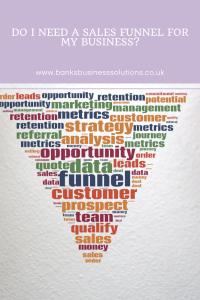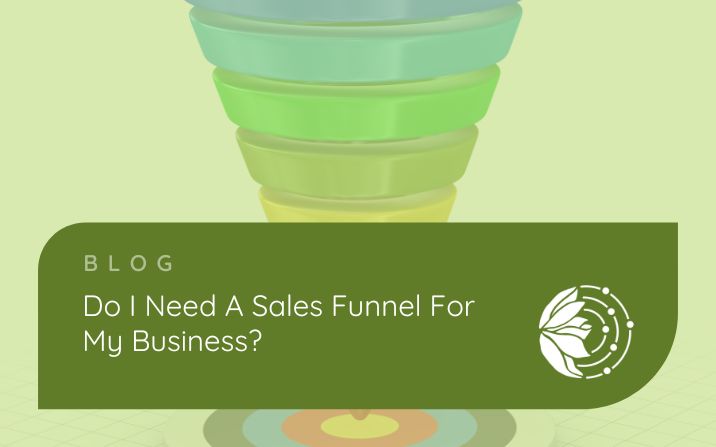Do I need a sales funnel for my business?
I hear a lot of business owners say they’re confused about what a sales funnel actually is, or how they hate the super long landing pages that go on and on about a product or service. That’s a sales funnel, right?
I think there’s a lot of misunderstandings around sales funnels and how they work for businesses of all shapes and sizes, so let me simplify things for you and explain why I think you do need a sales funnel for your business.
A sales funnel is about getting your leads from point A to point B
It’d be nice to think that someone spots your awesome Tweet and decides to buy from you there and then, unfortunately, that seldom happens, if ever.
We’re all getting increasingly savvy at shopping around for the best deal or service provider, digging deep to make sure we’re finding the right fit for us and there are no negative reviews or bad press going on.
Obviously, your prospective customers are doing exactly the same thing.
It’s your job to entice those fresh leads from their first glimpse of you through to the point of sales, giving them the reassurances and credibility that they need that you’re the best person for them (service or product) – and that’s the point of a sales funnel.
A sales funnel literally “funnels” those leads down into your ideal customers
Not everyone spotting that awesome tweet will be the right match for your business and what you have to offer, so a sales funnel acts as a way to filter out the bad matches and get your ideal customers through the door.
There are a few key steps in a sales funnel that helps your leads to identify you as the best fit for them while giving those bad matches plenty of escape opportunities, they are:
- Awareness
- Interest
- Evaluation
- Decision
- Purchase
Awareness is the start of your sales funnel. The social media posts, blogs, articles and press releases that alert people that you exist and how you can help them. It takes around 6 – 8 touchpoints, times people become aware of you, before they consider buying from you, so you need multiple points for people to enter your funnel at (and why reusing your blog content can be a wise move).
Interest is the landing page stage, and no, they don’t need to be thousands of words long. It’s true that long-form copy can be effective but only in the hands of an experienced copywriter who knows how to use language and persuasion tactics effectively. At this point your leads are already aware and interested in what you do, so you’re presenting your best offer and putting out there what you want from them – it can be making a sale, arranging a consultation or simply subscribing to your email list.
A sales funnel is vital for credibility and authority in purchasing decisions
Social media marketing and being active online goes a long way in gaining a good reputation and credibility in what you do, but before people buy from you they want to see “proof” of what you do, and using a sales funnel is a great way to achieve this.
This is what we refer to as the evaluation stage of the sales funnel.
You’ll have noticed in landing pages how testimonials, Facebook reviews, etc are sprinkled into the copy to reinforce what’s being said, right? That’s exactly what we’re talking about here. Once you’ve presented the information for your target audience to evaluate, you need to provide proof to help guide their decision.
A landing page is a great way to present the offer, the social proof and an easy way to buy in one place, but it can just as easily be your website that does the job here.
The key is to provide as much information and social proof as you can so that your leads can evaluate what’s available and make an informed decision on whether to choose you or someone else.
Putting a call to action (CTA) at the bottom of your sales funnel is essential to guide the purchase, but as different members of your target audience will evaluate and decide at different points of your landing page, website or other offer, it’s a good idea to have a few CTAs dotted around to catch their interest.
Take the time to map out your sales funnel
Now you know that a sales funnel is a way of getting a lead from noticing you to buying from you and that they need social proof and information along the way, you need to map out their journey. It could be something like this:
- Instagram post leading to a blog post
- The blog post offers a freebie for a mailing list sign up
- Introduce the offer in an email and direct to a landing page
- The landing page has the offer, testimonials, case studies and other information with a call to action
- Subsequent email reminds them of the offer with a direct call to action
That’s it, point A (Instagram) to point B (call to action) with enough information between those two points to help the lead identify you as a good fit, and bad matches to know they need to look elsewhere.
Chances are you’re already using a sales funnel type strategy for your business marketing, but do take the time to make sure you’ve got every step covered and consider ways you can make it even easier for your prospective customers to buy from you in the future.

